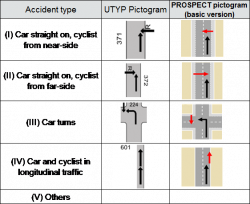PROSPECT results of the first period: Car-to-cyclist crashes in Europe and derivation of use cases as basis for test scenarios of next generation ADAS
Car-to-cyclist crashes in Europe and derivation of use cases as basis for test scenarios of next generation Advanced Driver Assistance System (ADAS): In the first year of the project, PROSPECT team investigated crashes involving one passenger car and one cyclist in several European crash databases looking for all injury severity levels (slight, severe and fatal). These data sources included European statistics from Community Database on Accidents on the Roads in Europe (CARE), data on a national level from Germany, Sweden and Hungary, as well as detailed accident information from these three countries using The German In-Depth Accident Study (GIDAS), the Volvo Cars Cyclist Accident database and Hungarian in-depth accident data, respectively. The most frequent accident scenarios were studied and Use Cases were derived considering the key aspects of these crash situations (e.g. view orientation of the cyclist and the car driver’s manoeuvre intention). The highest ranked of these Use Cases have subsequently been taken forward to form an appropriate basis for the development of Test Scenarios. Latest information on car-to-cyclist crashes in Europe was compiled including details on the related crash configurations, driving directions, outcome in terms of injury severity, accident location, other environmental aspects and driver responsibilities. The majority of car-to-cyclist crashes occurred during daylight and in clear weather conditions. Car-to-cyclist crashes in which the vehicle was traveling straight and the cyclist is moving in line with the traffic were found to result in the greatest number of fatalities. If slightly and seriously injured cyclists were also considered, a different order of crash patterns arose, according to the three considered European countries. A total of 29 Use Cases were derived considering the group of seriously or fatally injured cyclists and 35 Use Cases were derived considering the group of slightly, seriously or fatally injured cyclists. Finally, regarding car-to-cyclist crashes, five Accident Scenarios were identified: (I) “Car straight on, cyclist from nearside”, (II) “Car straight on, cyclist from far side”, (III) “Car turns”, (IV) “Car and cyclist in longitudinal traffic” and (V) “Others”. The highest ranked Use Case describes the collision between a car turning to the nearside and a cyclist riding on a bicycle lane against the usual driving direction (see Fig.).
Keywords
Vulnerable Road Users (VRU), Autonomous Emergency Braking (AEB), Active Safety
Countries
Spain



